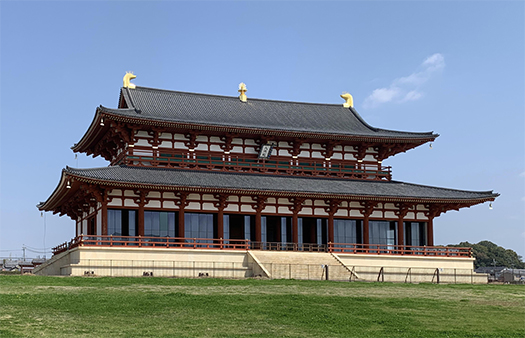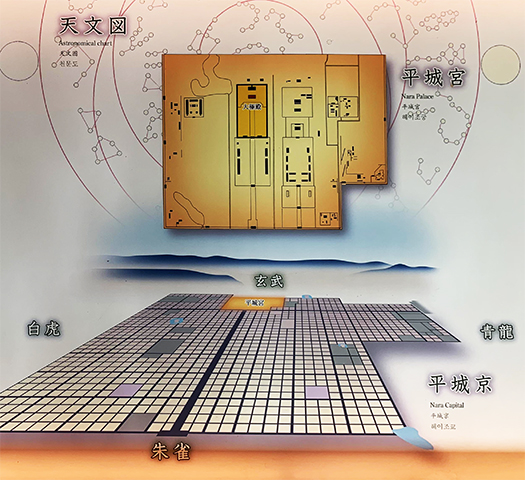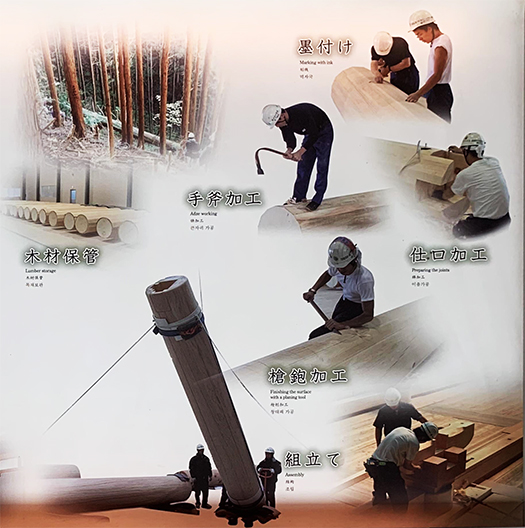

平城京を国家中心とするというのはやはり「中華思想」。
中国に於いて唐という強大な国家が成立してその中核的制度として
律令体制と仏教文化が普遍的なるものとされた。
この東アジア世界情勢に対応し日本も統一国家の確立が進んだ。
飛鳥京の時代はローカルな「王」の時代だったけれど、
天武帝が創始した「天皇号」と国号としての日本の確定と同時に
律令制度と国分寺・国分尼寺の全国への波及が実現していったのでしょう。
このように中央集権国家体制を確立していくときに
中国の王朝との関係で日本は「別の中華」であると方向を定めた。
聖徳太子が外交的に宣命した「日出ずる国」姿勢こそが基本外交方針。
この宣言で朝鮮半島の国家群とは違う体制を目指したのだと思える。
百済救援の白村江敗戦以降の日本外交は素晴らしかったのではないか。
今日的に考えて見るとそのすごさがよくわかる。
戦争には負けたのに外交的には勝利したと思える。
日本の王権が永く存続してきたひとつの根拠がこの時期の外交手腕。
一方で、それとは別次元の選択として、唐の進化した国家体制は受容した。
多様性のある日本国内各地域に対して「和を以て貴し」となしながら、
天皇王権はより強化して中華としての実質確立を目指した。
この平城京の中核である平城宮の建築思想は唐の王朝建築と同様の設計思想。
この大極殿は平城京の最北方に位置させて、そこから朱雀門、
さらにその最南端に「羅生門」を造営して首都都市計画としている。
「大極」とは古代中国思想の核心である天文思想で北極星。
そこで最重要な国家儀式を執り行うことで「中華」たる実質を具現化した。


上の写真群は復元建築の様子の記録写真とのこと。
相当の建築史研究に基づいて技術作法も検証されて復元されたことがわかる。
個人的には飛鳥京「大極殿」と見なせるエビノコ郭正殿は掘っ立て柱建築であるのに
この平城宮第1次太極殿では基壇上に築かれていることが目を引いた。
エビノコ郭正殿は「飛鳥浄御原宮・大極殿」と考えれば創建は681年推定。
この平城宮太極殿創建は710年と推定されるので、
建築史的には30年程度で最上級威信建築で大きく設計思想が変わったと思える。
中国王権に対しては独立姿勢を強めながらその建築技術は受容したのか。
ちなみに現代に残る京都紫宸殿建築では基壇の外形は認められない。
この平城宮段階でどのような設計意図があり、また建築技術者が
どういった素性の人々であったのか、もっと探索してみたいと思います。
白村江敗戦以降、百済の避難民が大量に帰化したことと関連するようにも思う。
この平城宮大極殿の施工は竹中工務店とのこと。
きのう見た「大極門」は清水建設だったので、この両社、
相当の「つばぜり合い」がこの間、あったのだろうなとムダな推測(笑)。
永く残る国家の歴史的威信建築と考えると無理もないでしょうか。
English version⬇
The Idea of the Space-Centered Chuuka “Daigoku-den” (Great Pole Hall): Exploration of Heijo-kyo, Nara – 18
The central building of the nation until the Asuka Palace was a dugout structure, but the Heijo-kyo Palace adopted a “basement” structure. The difference in time is more than 30 years. Why the difference in design philosophy? Heijo-kyo Palace
The idea of Heijo-kyo as the center of the nation is still the “Chuuka idea”.
In China, the Tang Dynasty was established as a powerful state, and the Ritsuryo system and Buddhist culture were considered universal as its core institutions.
The Ritsuryo system and Buddhist culture were considered universal.
In response to this world situation in East Asia, Japan also made progress in establishing a unified state.
The Asuka-kyo period was the era of local “kings.
Emperor Temmu established the “Emperor Name” and Japan as a country name, and at the same time
the Ritsuryo system and the spread of Kokubunji and Kokubuninji temples throughout the country must have been realized.
When establishing the national system in this way
Japan was oriented to be “another China” in relation to the Chinese dynasties.
The “Land of the Rising Sun” posture that Prince Shotoku diplomatically proclaimed is the basic foreign policy.
It seems that with this declaration, Japan aimed to establish a system different from the group of states on the Korean peninsula.
The diplomacy of the Japanese nation after the defeat at the Hakuchon River must have been excellent.
The greatness of Japan’s diplomacy after the defeat at the Paekchon River can be clearly seen when we look at it today.
It seems that Japan lost the war, but won the war diplomatically.
One of the roots of the longevity of Japanese kingship is the diplomatic skill of this period.
On the other hand, as a choice of a different dimension, the Tang Dynasty’s evolving state system was acceptable.
While “harmony is the best way to be noble” toward the diverse regions of Japan, the Emperor’s royal authority was further strengthened by the Chinese.
The emperor’s royal authority was further strengthened in order to establish a substantial Chinese state.
The architectural concept of Heijo-kyo Palace, the core of Heijo-kyo Capital, was similar to that of the Tang Dynasty.
The Daigoku-den was located in the northernmost part of Heijo-kyo, and the Suzaku-mon Gate was built from there.The capital city was planned by building the Suzaku Gate at the northernmost part of Heijo-kyo and the Rashomon Gate at the southernmost part of the palace.
The “Great Pole” is the North Star in ancient Chinese astronomical thought, the core of ancient Chinese thought.
By performing the most important national ceremonies there, the substance of “China” was embodied.
The above group of photos is a record of the restoration of the building.
It can be seen that the restoration was based on considerable research on architectural history and verification of technical methods.
Personally, I think that the Ebinoko-kaku Shoden, which can be regarded as the “Daigoku-den” of Asuka-kyo, is a dugout pillar building, but the restored building is a “dugout pillar” building.
The first Taigoku-den, which can be regarded as the “Daigoku-den” of Asuka-kyo, is built on a platform, which is what caught my attention.
If the Ebinoko-gaku Shoden is considered to be the “Daigoku-den of Asuka Jomihara Palace,” it is estimated to have been built in 681.
Since the Taigoku-den of Heijo Palace is estimated to have been built in 710, it is estimated to have been built in 681.
In terms of architectural history, the design concept of the highest level of prestige architecture seems to have changed significantly over the past 30 years or so.
Did the architects accept the architectural techniques of the Chinese royalty while strengthening their independent stance toward them?
Incidentally, the modern Shikikinden in Kyoto does not have the external form of a platform.
What was the design intent at the Heijo Palace stage, and who were the architectural engineers?
I would like to explore more about the design intent and the background of the architectural engineers at this stage of the Heijo Palace.I think it may be related to the large number of Baekje refugees who were naturalized after the defeat of the Baekchon River.
Takenaka Corporation is the contractor for the Daigoku-den, the main building of Heijo-kyo Palace.
The Daigokumon, which we saw yesterday, was constructed by Shimizu Corporation.
I guessed needlessly that there must have been a considerable “sparring match” between the two companies (laugh).
It is not unreasonable to think that this is a historical prestige building of the nation that will remain for a long time.
Posted on 5月 4th, 2022 by 三木 奎吾
Filed under: 住宅マーケティング, 歴史探訪







コメントを投稿
「※誹謗中傷や、悪意のある書き込み、営利目的などのコメントを防ぐために、投稿された全てのコメントは一時的に保留されますのでご了承ください。」
You must be logged in to post a comment.